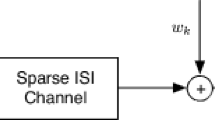Abstract
In this work, a sequential estimation algorithm based on branch metric is used as channel equalizer to combat intersymbol interference in frequency-selective wireless communication channels. The bit error rate (BER) and computational complexity of the algorithm are compared with those of the maximum likelihood sequence estimation (MLSE), the recursive least squares (RLS) algorithm, the Fano sequential algorithm, the stack sequential algorithm, list-type MAP equalizer, soft-output sequential algorithm (SOSA) and maximum-likelihood soft-decision sequential decoding algorithm (MLSDA). The BER results have shown that whilst the sequential estimation algorithm has a close performance to the MLSE using the Viterbi algorithm, its performance is better than the other algorithms. Beside, the sequential estimation algorithm is the best in terms of computational complexity among the algorithms mentioned above, so it performs the channel equalization faster. Especially in M-ary modulated systems, the equalization speed of the algorithm increases exponentially when compared to those of the other algorithms.
Similar content being viewed by others
References
Wozencraft J.M., Reiffen B. (1961) Sequential decoding. Massachusetts Institute of Technology Press, Cambridge, MA, pp 25–46
Viterbi J. (1967) Error bounds for convolutional codes and an asymptotically optimum decoding algorithm. IEEE Transactions on Information Theory IT-13: 260–269
Fano R.M. (1963) A heuristic discussion of probabilistic decoding. IEEE Transactions on Information Theory IT-9: 64–74
Zigangirov K.Sh. (1966) Some sequential decoding procedures. Problemy Peredachi Informatsii 2(4): 13–25
Jelinek F. (1969) Fast sequential decoding algorithm using a stack. IBM Journal of Research and Development 13: 675–678
Chevillat P.R., Costello D.J. Jr (1977) A multiple stack algorithm for erasurefree decoding of convolutional codes. IEEE Transactions on Communications C-25: 1460–1470
Wei C., Riedel S., Hagenauer J. (1996) Sequential decoding using a priori information. Electronics Letters 32: 1190–1191
Li K.P., Kallel S. (1999) A bidirectional multiple stack algorithm. IEEE Transactions on Communications C-47: 6–9
Haccoun D., Ferguson M.J. (1975) Generalized stack algorithms for decoding convolutional codes. IEEE Transactions on Information Theory IT-21: 638–651
Johanesson R., Zigangirov K.Sh. (1999) Fundamentals of convolutional coding. IEEE Press, Piscataway, NJ
Jacobs I.M., Berlekamp E.R. (1967) A lower bound to the distribution of computation for sequential decoding. IEEE Transactions on Information Theory IT-13: 167–174
Forney G.D. Jr (1972) Maximum-likelihood sequence estimation of digital sequences in the presence of intersymbol interference. IEEE Transactions on Information Theory IT-18(3): 363–378
Widrow B., Kalman R.E., DeClaris N. (1970) Adaptive filters: Aspects of network and system theory. Holt, Rinehart and Winston, New York
Godard D.N. (1974) Channel equalization using a Kalman filter for fast data transmission. IBM Journal of Research & Development 18: 267–273
Berrou, C., Glavieux, A., & Thitimajshima, P. (1993). Near shannon limit error-correcting coding and decoding: Turbo codes. In Proceeding of IEEE international conference on communications (pp. 1064–1070) Geneva, Switzerland.
Xiong F., Zerik A., Shwedyk E. (1990) Sequential sequence estimation for channels with intersymbol interference of finite or infinite Length. IEEE Transactions on Communications 38(6): 795–804
Xiong F., Dai Q.Y., Shwedyk E. (1993) Computational complexity of sequential sequence estimation for intersymbol interference channels. IEEE Transactions on Communications 41(2): 332–337
Xiong F., Shwedyk E. (1993) Sequential sequence estimation for multiple-channel systems with intersymbol and interchannel interference. IEEE Transactions on Communications 41(2): 322–331
Xiong F. (1995) Sequential decoding of convolutional codes in channels with intersymbol interference. IEEE Transactions on Communications 43(2/3/4): 828–836
Haccoun D., Kallel S. (1991) Application of multiple path sequential decoding for intersymbol interference reduction problem. IEE Proceedings-I 138(1): 21–31
Tungsrisaguan, E., & Rajatheva, R. M. A. P. (2001). Soft-output sequential algorithm for signal estimation over frequency selective fading channel. In Global Telecommunications Conference, GLOBECOM ’01. IEEE 2 (pp.1241–1245).
Han Y.S., Chen P.N., Wu H.B. (2002) A maximum-likelihood soft-decision sequential decoding algorithm for binary convolutional codes. IEEE Transactions on Communications C-50: 173–178
Sellami, N., Siala, M., & Fijalkow, I. (2004). Low-complexity equalizers for MIMO frequency selective channels. In Control, communications and signal processing first international symposium (pp. 175–178).
Penther, B., Castelain, D., & Kubo, H. (2000). A modified turbo-detector for long delay spread channels. In International symposium on turbo-codes, Brest, France.
Çavdar T., Gangal A. (2007) A new sequential decoding algorithm based on branch metric. Wireless Personal Communications 43(4): 1093–1100
Çavdar, T. (2003). A new sequential block data estimation algorithm and its performance analysis over frequency selective channels. Ph.D. dissertation, Department of Electronics Engineering, Karadeniz Technical University, Turkey.
Proakis J.G. (2000) Digital communications (4th ed.). McGraw Hill, New York
Lin S., Costello D.J. Jr (1983) Error control coding: Fundamentals and applications. Prentice-Hall, Englewood Cliffs, NJ
Author information
Authors and Affiliations
Corresponding author
Rights and permissions
About this article
Cite this article
Çavdar, T., Gangal, A. Application of Sequential Estimation Algorithm Based on Branch Metric to Frequency-Selective Channel Equalization. Wireless Pers Commun 55, 655–664 (2010). https://doi.org/10.1007/s11277-009-9827-8
Published:
Issue Date:
DOI: https://doi.org/10.1007/s11277-009-9827-8




